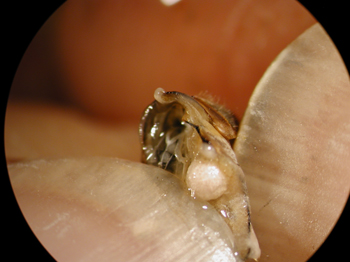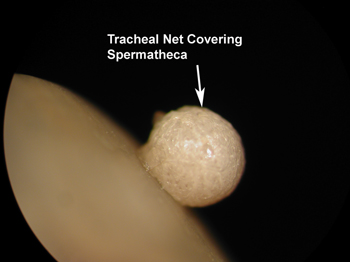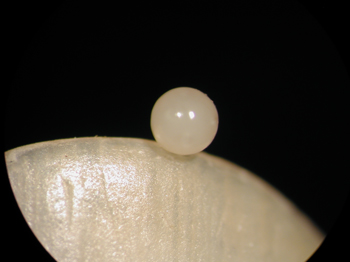Instrumental Insemination of Honey Bee Queens
Insemination Techniques
- Eversion of the Honey Bee Drone Endophallus for Insemination
- Semen Collection for Artificial Insemination in Honey Bees
- Insemination of the Honey Bee Queen
- Field Dissection of the Honey Bee Queen Spermatheca
These pages are brought to you by Susan Cobey at www.honeybee.breeding.com
For classes in instrumental insemination by Susan Cobey, see: The UC Davis entomology website
Grasp the queen’s terminal abdominal segments, dorsally and ventrally (top and bottom). With your fingernails or forceps, pull these segments apart separating them from the rest of the queen’s body.
The intestine and a large, shapeless, clear poison sac are exposed. Among this is the spermatheca, a white, spherical structure, about 1 mm in diameter. This will appear whitish and rough in texture, due to a covering net of trachea.
Tease the spermatheca out of the body cavity with your thumbnail. Gently roll the spermatheca between your fingers to remove the tracheal net. This will collapse in a small separated white mass. The color shade and density of the spermatheca indicates the reproductive status of the queen. In the virgin queen, this is crystal clear.
The spermatheca of a well mated queen is the color of drone semen, a creamy, coffee au lait color with a pattern of marbled swirls. A cloudy or milky whitish appearance, as in the bottom left photo, indicates an inadequate supply of semen. The queen was not mated properly or is old and has used up her stores.
Becoming familiar and with and recognizing the varying degrees of spermatheca coloration and density is a valuable management tool.
Download a .pdf: Field Dissection of the Honey Bee Queen Spermatheca
EN Español: Disección de espermateca en el Campo








